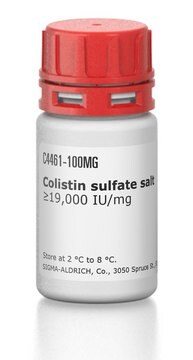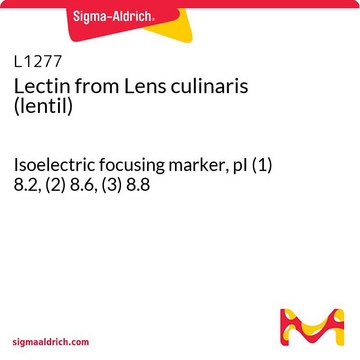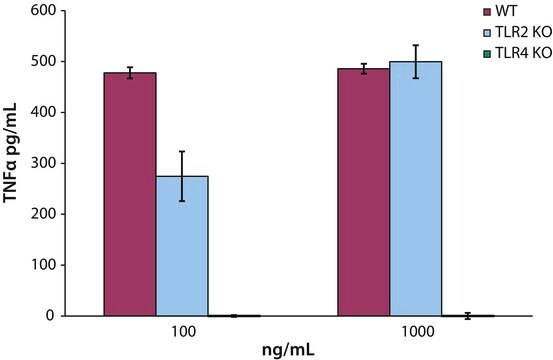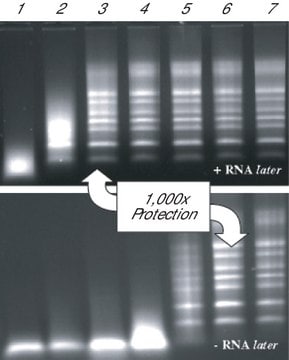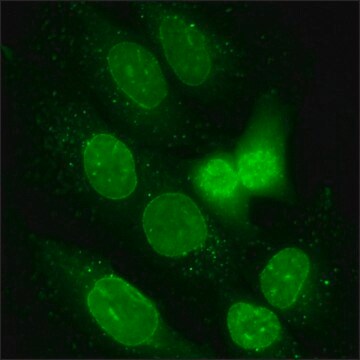L7011
Lipopolysaccharides from Salmonella enterica serotype minnesota
purified by trichloroacetic acid extraction
Synonym(s):
LPS
Sign Into View Organizational & Contract Pricing
All Photos(1)
About This Item
Recommended Products
biological source
Salmonella enterica (Serotype minnesota)
Quality Level
form
lyophilized powder
purified by
trichloroacetic acid extraction
impurities
1-10% Protein (Lowry)
shipped in
ambient
storage temp.
2-8°C
Looking for similar products? Visit Product Comparison Guide
General description
Lipopolysaccharides (LPSs) are characteristic components of the cell wall of Gram-negative bacteria. LPS and its lipid A moiety stimulate cells of the innate immune system by the Toll-like receptor 4 (TLR4), a member of the Toll-like receptor protein family, which recognizes common pathogen-associated molecular-patterns (PAMPs).
This product is TCA extracted from Salmonella minnesota. The source strain is ATCC 9700.
Biochem/physiol Actions
Lipopolysaccharides (LPS) are localized in the outer layer of the membrane and are, in noncapsulated strains, exposed on the cell surface. They contribute to the integrity of the outer membrane, and protect the cell against the action of bile salts and lipophilic antibiotics.
Preparation Note
The product is soluble in water (5 mg/ml) or cell culture medium (1 mg/ml) yielding a hazy, faint yellow solution. A more concentrated, though still hazy, solution (20 mg/ml) has been achieved in aqueous saline after vortexing and warming to 70-80 oC. Lipopolysaccharides are molecules that form micelles in every solvent. Hazy solutions are observed in water and phosphate buffered saline. Organic solvents do not give clearer solutions. Methanol yields a turbid suspension with floaters, while water yields a homogeneously hazy solution.
Other Notes
To gain a comprehensive understanding of our extensive range of Lipopolysaccharides for your research, we encourage you to visit our Carbohydrates Category page.
Related product
Product No.
Description
Pricing
Storage Class
11 - Combustible Solids
wgk_germany
WGK 3
flash_point_f
Not applicable
flash_point_c
Not applicable
ppe
Eyeshields, Gloves, type N95 (US)
Choose from one of the most recent versions:
Already Own This Product?
Find documentation for the products that you have recently purchased in the Document Library.
Zhendong Zhu et al.
Cryobiology, 88, 1-8 (2019-04-30)
Mammalian spermatozoa are highly susceptible to reactive oxygen species (ROS) stress. The aim of the present study was to investigate whether and how melatonin protects rabbit spermatozoa against ROS stress during cryopreservation. Semen was diluted with Tris-citrate-glucose extender in presence
Pei Ching Low et al.
The Journal of cell biology, 190(6), 1053-1065 (2010-09-15)
Phosphoinositide 3-kinase (PI3K) p110 isoforms are membrane lipid kinases classically involved in signal transduction. Lipopolysaccharide (LPS)-activated macrophages constitutively and abundantly secrete proinflammatory cytokines including tumor necrosis factor-α (TNF). Loss of function of the p110δ isoform of PI3K using inhibitors, RNA-mediated
Guangming Ren et al.
The EMBO journal, 38(6) (2019-02-23)
Deubiquitination of NLRP3 has been suggested to contribute to inflammasome activation, but the roles and molecular mechanisms are still unclear. We here demonstrate that ABRO1, a subunit of the BRISC deubiquitinase complex, is necessary for optimal NLRP3-ASC complex formation, ASC
Anna Lünemann et al.
Journal of immunology (Baltimore, Md. : 1950), 181(9), 6170-6177 (2008-10-23)
Microglia are resident macrophage-like APCs of the CNS. To avoid escalation of inflammatory processes and bystander damage within the CNS, microglia-driven inflammatory responses need to be tightly regulated and both spatially and temporally restricted. Following traumatic, infectious, and autoimmune-mediated brain
Ryusuke Yoshimi et al.
Journal of immunology (Baltimore, Md. : 1950), 182(12), 7527-7538 (2009-06-06)
The tripartite motif (TRIM) family member, TRIM21, is an E3 ubiquitin ligase for IFN regulatory factor (IRF)3 and IRF8 that functions in both innate and acquired immunity. It is also an autoantigen known as Ro52/SS-A. The function of TRIM21 in
Our team of scientists has experience in all areas of research including Life Science, Material Science, Chemical Synthesis, Chromatography, Analytical and many others.
Contact Technical Service

